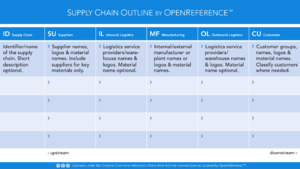Actions
Supply Chain Outline {{{level}}}
SCO
Difference between revisions of "SCO"
m (1 revision imported) |
|
(No difference)
| |
Revision as of 19:50, 5 July 2017
Supply Chain Outline Development is a Practice to develop new or document existing supply chain outlines. A Supply Chain Outline lists all nodes that make up a supply chain. Examples of such nodes (locations, functions or partners) include named Warehouses, Plants, Distribution Centers, and other locations where Supply Chain Activities occur.
- Suppliers (SU) - The internal or external partners that provide key materials for this supply chain. This list is typically limited to the key materials, suppliers or supplier classes.
- Inbound Logistics (IL) - The freight forwarders, carriers, internal functions or external partners that provide transport and other logistics services (e.g. export, import) for this supply chain. This list is typically limited to the primary service providers.
- Warehouses (WH) - The Warehouse facilities, yards, internal functions or external partners that provide warehousing and other services (e.g. kitting, breaking bulk) for this supply chain.
- Manufacturing (MF) - The plants, internal functions or external partners that provide manufacturing, repair, remanufacturing, recycling activities for this supply chain.
- Distribution Centers (DC) - The DCs, warehouse facilities, internal functions or external partners that provide distribution center and other services (e.g. repacking, consolidation, de-consolidation, warehousing) for this supply chain.
- Outbound Logistics (OL) - The freight forwarders, carriers, internal functions or external partners that provide transport and other logistics services (e.g. export, import) for this supply chain. This list is typically limited to the primary service providers.
- Installers (IS) - The internal functions or external partners (e.g. installers, distributors) that provide on-site installation, assembly activities for customers for this supply chain.
- Channel Partners (CH) - The external partners that provide local presence, warehousing, delivery services in regions where this supply chain would have no presence.
- Customers (CU) - The internal functions or external customers (e.g. consumers, strategic partners) that acquire materials or services from this supply chain.
Consider the Channels, Customer Segments, Key Resources, Key Partners, and Key Activities from the Business Model Canvas when completing the template.
Each line represents a supply chain; linking products from suppliers to customers.
Community Importance Rating:Hierarchy
| No children identified | x |
Process(es)
| ID | Name | Level | x |
|---|---|---|---|
| A102 | Discover Supply Chains | 3 | A102 |
| A103 | Segment Supply Chains | 3 | A103 |
| G301 | Define Context | 3 | G301 |
"{{{level}}}" is not a number.
Business, Strategy, Key Partners, Key Activities, Key Resources, Value Propositions, Customer Relationships, Channels, Customer Segments A standard template and methodology to develop new or document existing business strategy

